New York's fanciest 'Korean wave' restaurants go where L.A. doesn't: caviar and kimchi
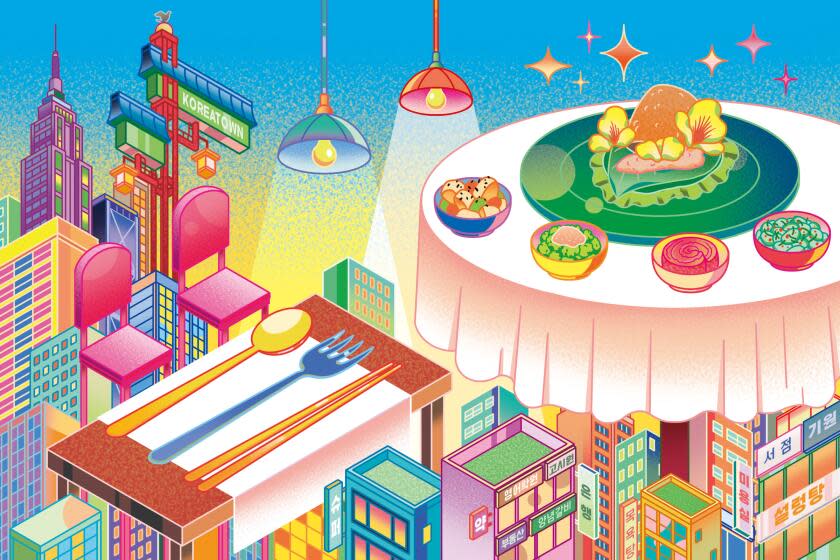
Near the end of a week spent delving into Manhattan's upwelling of modern Korean fine dining restaurants last fall, I watched a server at Oiji Mi light a blowtorch tableside and turn it toward a platter of Wagyu bavette steak carved into carpaccio rounds. A snug beige cloth was wrapped around the butane cylinder to hide any warning labels. It brought to mind a soft spa tunic.
So much about the display, and the tastes that followed, encapsulated the crossroads of theater, tradition and invention I experienced in New York — a recent juncture for Korean cuisine that exists in a separate universe from the one that thrives in Los Angeles.
While the server blazed the beef in front of us, she explained the dish, called samhap, a Korean term that can translate in context as “three tastes.” Over the beef she poured aged soy sauce infused with ginger and soy, and slid on an egg yolk to add creaminess. The meaty circles acted as wrappers. She instructed us to layer over morsels of Hokkaido uni and aged kimchi with a final dot of searing mustard, and gently lift the bundles with our chopsticks. Flavors tumbled over one another: richness, funk, pungent heat.
The samhap arrived as part of the meal’s third of five courses, flanked by two noodle-based feats conceived by chef and owner Brian Kim. One was cool, squiggly ramyun dressed in tahini-scallion sauce and crowned with lobster hunks stained scarlet from gochugaru-infused oil. The other presented lacy somyeon, obscured under sliced octopus, hearts of palm and charred leeks. Our upbeat server tipped Wagyu broth into the dish.
Read more:25 of the best Korean barbecue restaurants in Koreatown and beyond
“It’s usually about 10 million degrees so just be careful on the first couple of bites,” she cautioned. As it cooled, I could pick up the subtle spicing of garlic, ginger and something sweet — Asian pear, maybe — meant to recall the marinade for galbi, one of the menu’s many understated but constant callbacks to its anchor cuisine.
Between the seasonings in the stock and the tabletop-flamed steak, my taste buds were sending signals that said “Korean barbecue,” even as I watched sommeliers decant Barolos from the 75-page wine list and I admired the blend of clubby Deco fixtures and mottled textiles that nod to jogakbo, a style of Korean patchwork created by scraps of fabric.
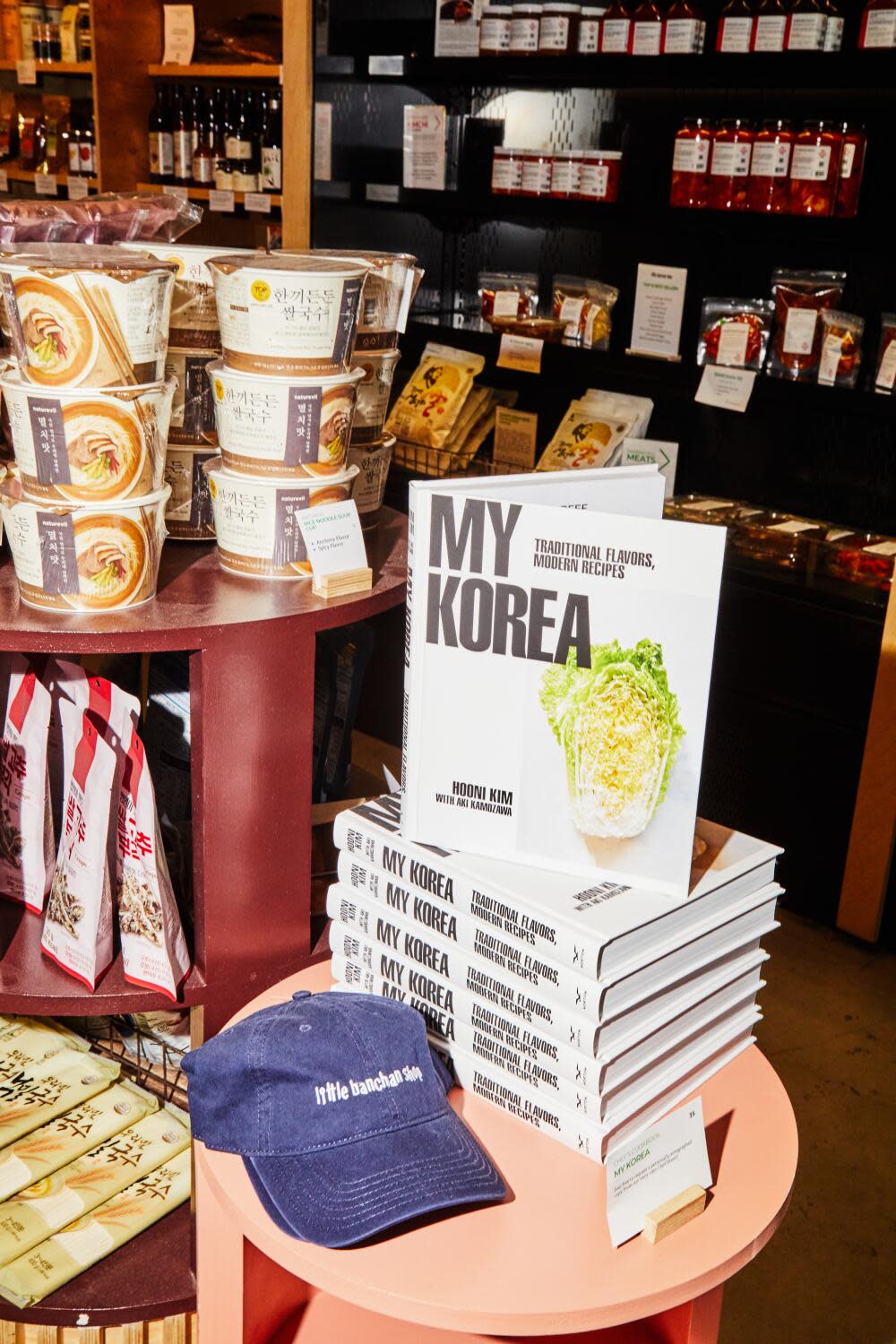
From Los Angeles, I’d been reading one NYC food writerafter another weighing in on the acceleration of a decade-long movement: Korean chefs had taken their native cuisine’s building blocks and, in the mold of Eurocentric grandeur, reconstructed flavors and presentations into elaborate tasting menus.
It’s a culinary crest of Hallyu, or “Korean wave,” the global rise of South Korean culture’s popularity that encompasses K-pop, film, TV dramas and video games. It makes sense that a fine-dining articulation of Korean cuisine would take root in New York, a world capital of finance and media, and specifically in Manhattan, with its singular concentration of wealth.
Four years after empire builder David Chang opened his now-closed omakase-style tasting menu, Momofuku Ko, with just 12 seats in 2008, chef Jungsik Yim arguably stoked the genre when he arrived from his upscale restaurant in Seoul and opened Jungsik in Tribeca in 2012. Laying thick white linens over tables, he served a dozen small, meticulous courses, including his signature dashi-braised octopus curling over gochujang aioli.
In the hands of these Korean chefs — many of whom had trained in European kitchens or at pedigreed Manhattan stalwarts like Per Se and Bouley — homey soups, ssams, porridges, bibimbaps and other traditional dishes transform into ornate geometries, often gilded with one or more of the codified quartet that signals Western luxury: caviar, truffles, Wagyu and uni. Some dining rooms are hushed, others lean more laidback, and prix fixe menus can range from $75 to $400 per person.
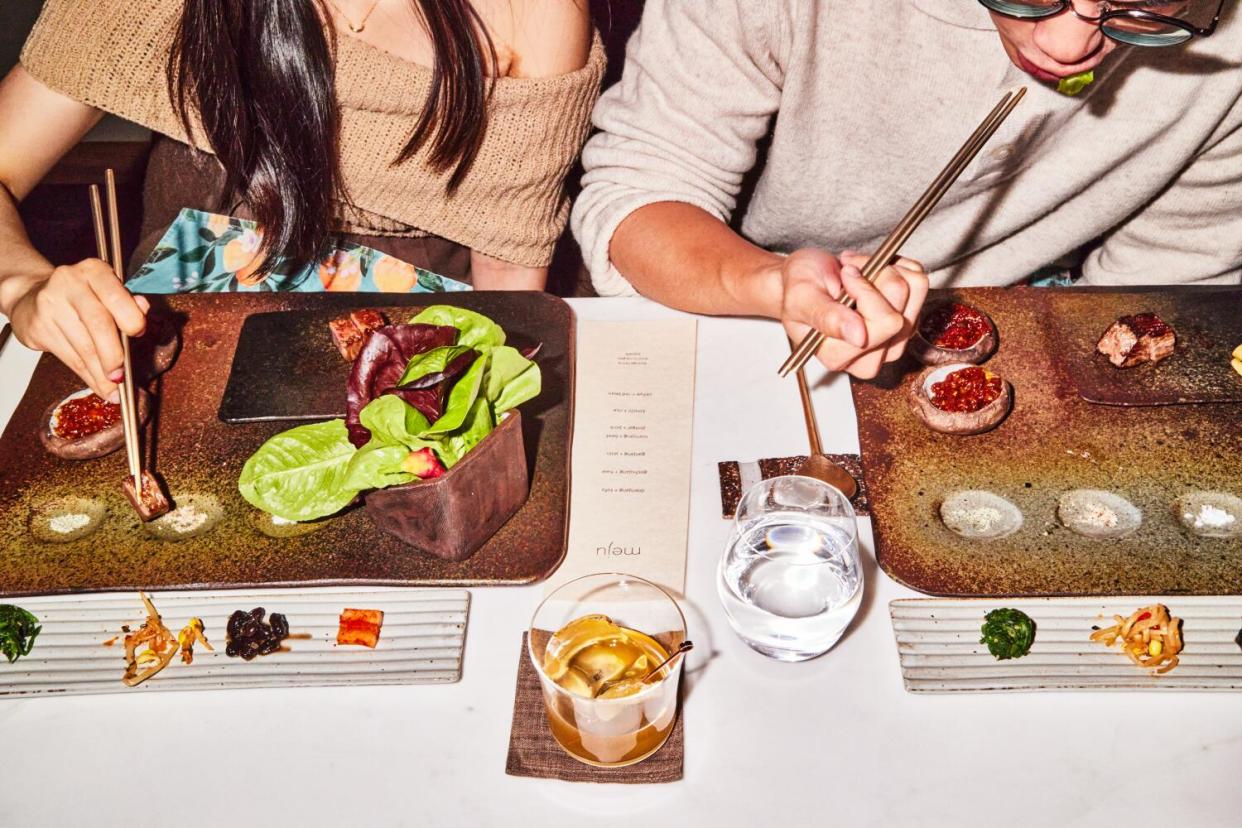
I couldn’t resist peering into a New York moment involving contemporary ideas of upscale Korean dining. Being a student of Korean foodways is essentially written in my job description as a Los Angeles critic. The cuisine is hand-stitched into the fabric of L.A.
Our metropolitan area has the largest Korean population in the United States. (The New York region has the second biggest.) L.A.’s Koreatown, in the city’s geographic and civic heart, pulses with energy and dichotomies and deliciousness. Restaurants serving time-honored vernacular cooking — roiling soondubu, delicate dumplings, reviving cold noodles, bossam feasts, heaps of tabletop-grilled galbi — have lined the neighborhood in strip malls and standalone buildings for decades, crowded among late-night bars, snack shops, coffee houses and dessert parlors, each expressing their microcosms of Korean culture.
Rapid-fire trend exchanges also bounce between Los Angeles and Seoul. As one tiny example, a stand on Vermont Avenue called Tangtastic set up four months ago inside a Korean fried chicken restaurant to dole out tanghulu, kaleidoscopic skewers of glassy, sugarcoated fruit that were among South Korea’s biggest viral food sensations last year.
Read more:7 favorite spots for Korean fried chicken in Koreatown
But starched sanctuaries meting out hours-long tasting menus that shoot for three Michelin stars in the European model? It’s simply not an L.A. thing. Moneyed Angelenos seem more inclined to drop hundreds of dollars at tiny, beautifully minimalist Japanese omakase counters, or in comfortable rooms serving the region's most pristine seasonal ingredients, rather than opulent rooms heavy on delicate china and starched tablecloths.
We are a bastion of traditional and casual Korean cooking, with only a handful of exceptional higher-end modern Korean upstarts, most of which come from a farmers market-based, personal-narrative perspective that flourishes in California.
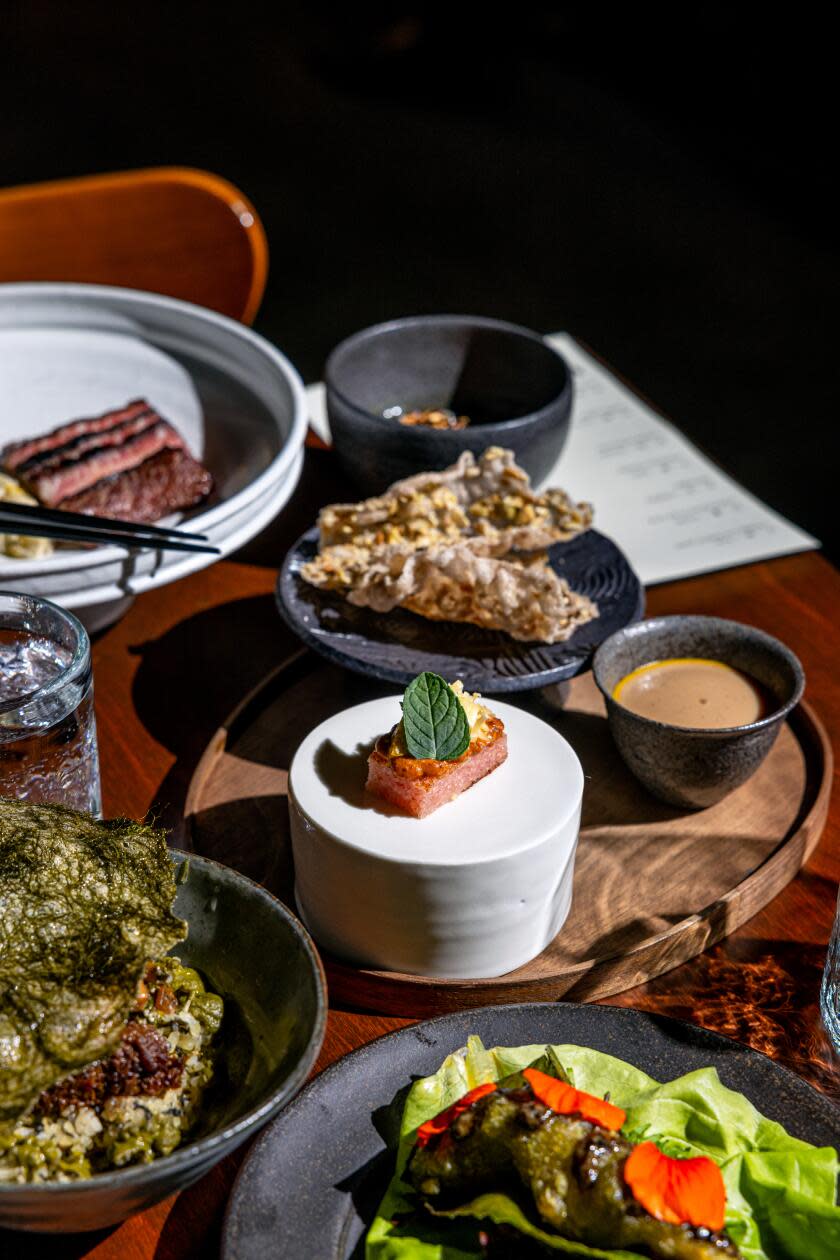
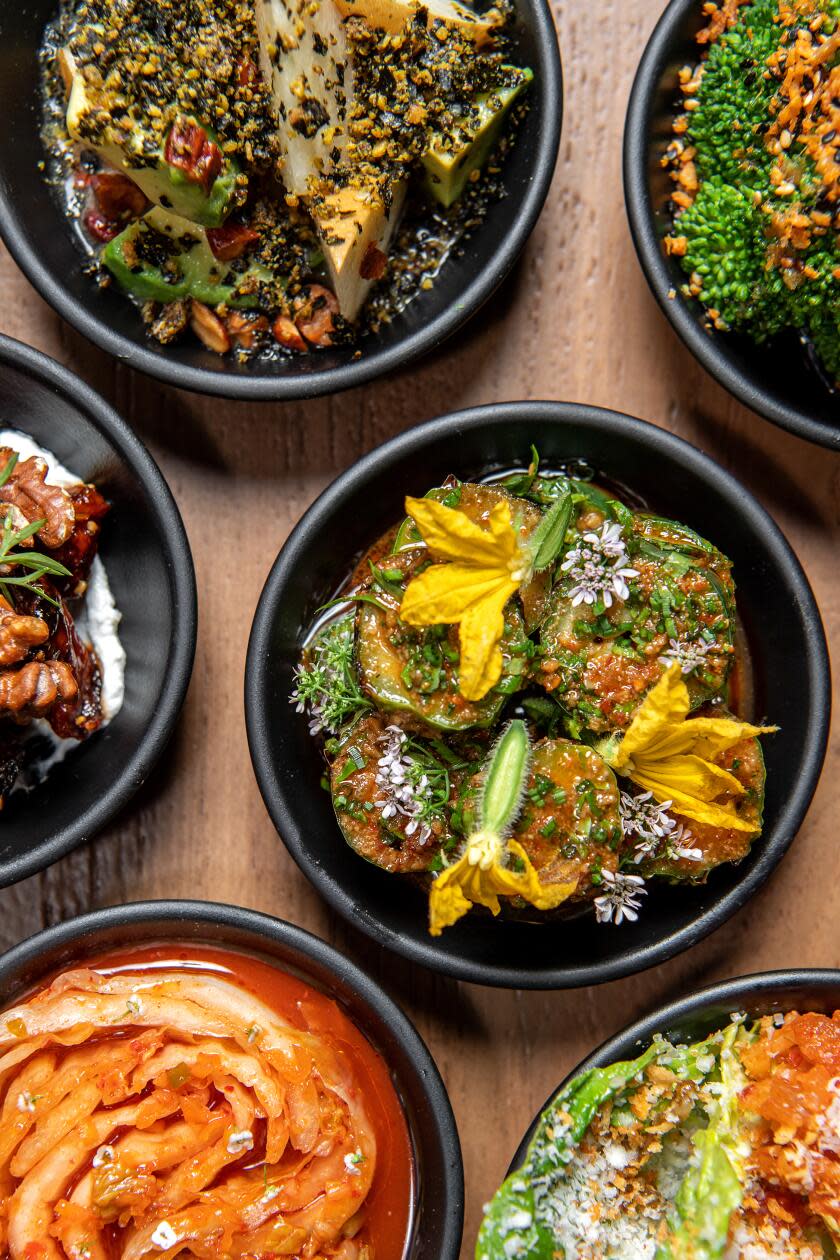
The best of them is Baroo in the Arts District, a reinvention of a project that began last decade with Kwang Uh assembling intricate, experimental grain bowls and pastas in a bare-bones Hollywood strip mall. Now Uh and wife Mina Park focus on a succinct $110 tasting menu, served at a just-right pace designed for Angelenos, with centerpieces like skate wing ssam cradled in butter lettuce with fresh herbs and brightening slicks of gooseberry emulsion and seaweed remoulade.
At Yangban, an exploration into identity from two accomplished Korean American chefs, married couple Katianna and John Hong prepare braised cod, mandu and other Korean cornerstones often spliced with Ashkenazi Jewish flavors, among other influences.
A highlight of the global-minded menu at Majordomo, which New York's Chang opened on the border of L.A.'s Chinatown in 2018, remains the colossal pork shoulder bossam, a trademark the chef introduced at Manhattan’s now-closed Ssäm Bar in 2006 and a reminder of his national influence on concepts of modern Korean food early in the millennium. (I do miss the version of gochu jeon — green chiles stuffed with ground meat and pan-fried — based on the recipe of Chang’s mother’s that he served when he first opened Majordomo.)
Starched sanctuaries meting out hours-long tasting menus that shoot for three Michelin stars in the European model? It’s simply not an L.A. thing.
Beyond this infrequent example of cross-pollination, the 2,500 miles between Los Angeles and New York tend to keep each city’s Korean dining culture distinct.
One could drudge comparisons infinitely. Take the presence of restaurant groups. In the New York Times last month, Priya Krishna wrote about Hand Hospitality, run by a pair of restaurateurs who prefer to keep a low profile but operate 21 booming Korean restaurants in New York. Their businesses span from the highest gastronomic temples to quick-service soup counters.
L.A. has Wonsuk “John” Kang, a former stockbroker turned food-industry pro who owns a half-dozen informal restaurants in Koreatown that mostly specialize in variations on Korean drinking foods. You’ll know them by the moniker behind the restaurant names: Seoul Night by Chef Kang, HanEuem by Chef Kang. None of them are fancy.
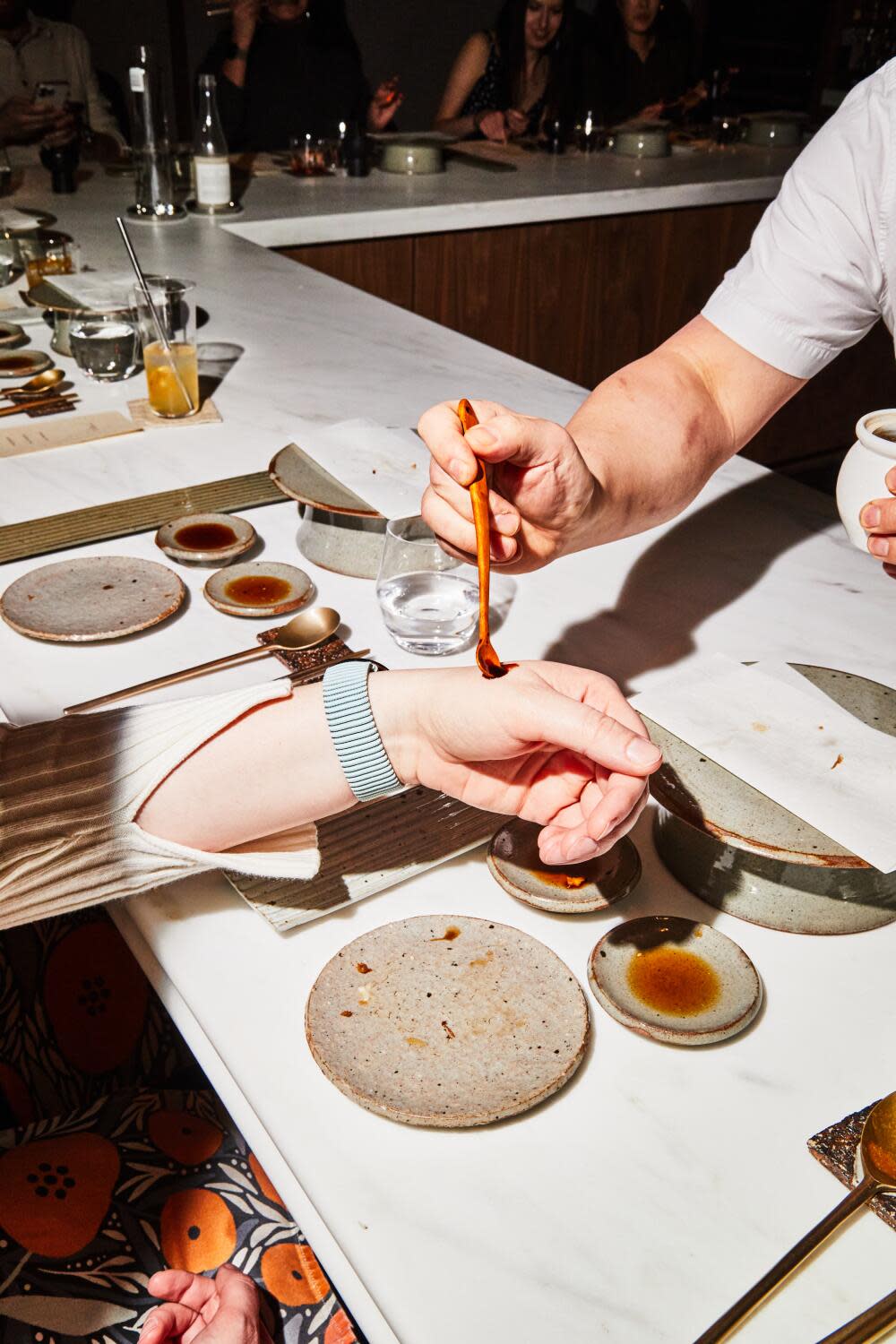
To say this expressly: L.A.’s Korean dining culture is consummate and exquisite as it is. For Angelenos with the curiosity and the means to travel to New York to know Korean food in new, posh frontiers, rewarding pleasures await.
There have been tentpole Korean innovations in Manhattan I’ve savored over the last decade. Cote opened in 2017, ingeniously fusing the American chophouse and Korean barbecue genres: Banchan and egg soufflé surround the tabletop grill, sputtering fat from nutty, nearly fudgy steaks that have been dry-aged in chambers glowing red in the restaurant’s basement. The all-in wine program from sommelier Victoria James straddles price ranges and global growing regions. I’m not surprised Cote has moved into expansion mode, with outposts in Miami and Singapore and a new NYC spinoff for fancy fried chicken and Champagne called Coqodaq.
And if Jungsik Yim sparked the ascent of what he christened “new Korean fine dining” a dozen years ago, married partners Ellia Park and chef Junghyun Park fueled the combustion when their tasting menu restaurant Atomix, housed in the subterranean level of a stunning NoMad townhouse, began dazzling diners in 2018. I have been among the wowed who gather around a 14-seat counter. The sculptural forms exude global modernism, and the caviar and truffles abound, but the ingredients clearly telegraph Korean origins: fermented vegetables and anchovies; silky raw bass or grouper with fruits appearing fresh or as lucid vinegars; strands of japchae reimagined as a sheet of pasta overlaying beef, black truffles and winter vegetables.
Each course at Atomix arrives with a card printed with an abstract image and placed down discreetly by a staffer. Their mystery can feel like a slow-reveal tarot reading, but the flip sides include genuinely absorbing information about the inspiration behind the creations and a detailed list of ingredients. (Aha! The unusual suppleness of Park’s mandu came from cornstarch.)
On the recent trip, at Oiji Mi, the way chef Kim grafted the essence of Korean cuisine into French techniques and dining room stagecraft was surgical in its execution, but the results transcended clinical precision, radiating a warmth I appreciated. Even a plate of sliced raw striped jack in seaweed vinaigrette, arranged over a precise circle of spaghetti squash and peeled green grapes set in a kinetic spiral, looked frozen in its visual perfection. Yet the tastes, once I steeled myself to demolish the art, were elemental and soul-satisfying.
It’s a culinary crest of Hallyu, or “Korean wave,” the global rise of South Korean culture’s popularity that encompasses K-pop, film, TV dramas and video games. It makes sense that a fine-dining articulation of Korean cuisine would take root in New York.
I skipped Bōm, the attached 12-course, $300-per-person meat-centric tasting menu room that Kim and partner Max Soh opened last year and that costs twice as much as Oiji Mi. But plenty of other highlights illuminated my days and nights.
Dining in the depths of Rockefeller Center, I’d never seen nor tasted a more beautiful jeon, a word that usually describes a flattish fritter. But at luxe Naro, the newest restaurant from the couple behind Atomix, the jeon was remade into a light, eggy disc of cod and potato with garnishes of spinach and cubed sea cucumber, pre-bathed in citrusy dipping sauce.
Two dishes at Jua in Tribeca shimmer in my memory: a single, Instagram-famous kimbap encasing tuna, crisped rice, avocado and pickled mountain yam in its seaweed wrapper, finished with an unholy gob of Osetra caviar; and a bowl of jook, conceived to almost fictional excess, thickened with a foie gras emulsion and darting with flavors of citrus and sesame. A lobe of abalone drifted through the porridge, staring up like a lidless golden eye.
Read more:19 best late-night hangouts in Koreatown to keep the party going
At Lysee, chef Eunji Lee’s jewel box of a pastry shop, I sipped a latte made with sujeonggwa (gingery cinnamon dessert punch) and indelicately wolfed down black sesame madeleines. Reserving an afternoon prix-fixe guaranteed her most coveted creation, an edible sculpture of a stubbly ear of corn in its husk: The duo of corn mousse and grilled corn cream melted into sunshine on the tongue. It made me glad, as the northeastern autumn encroached, that I was soon headed back west.
Before flying home, though, I passed through the Queens-Midtown Tunnel to Long Island City and the destination that gave my time in New York full-circle resonance.
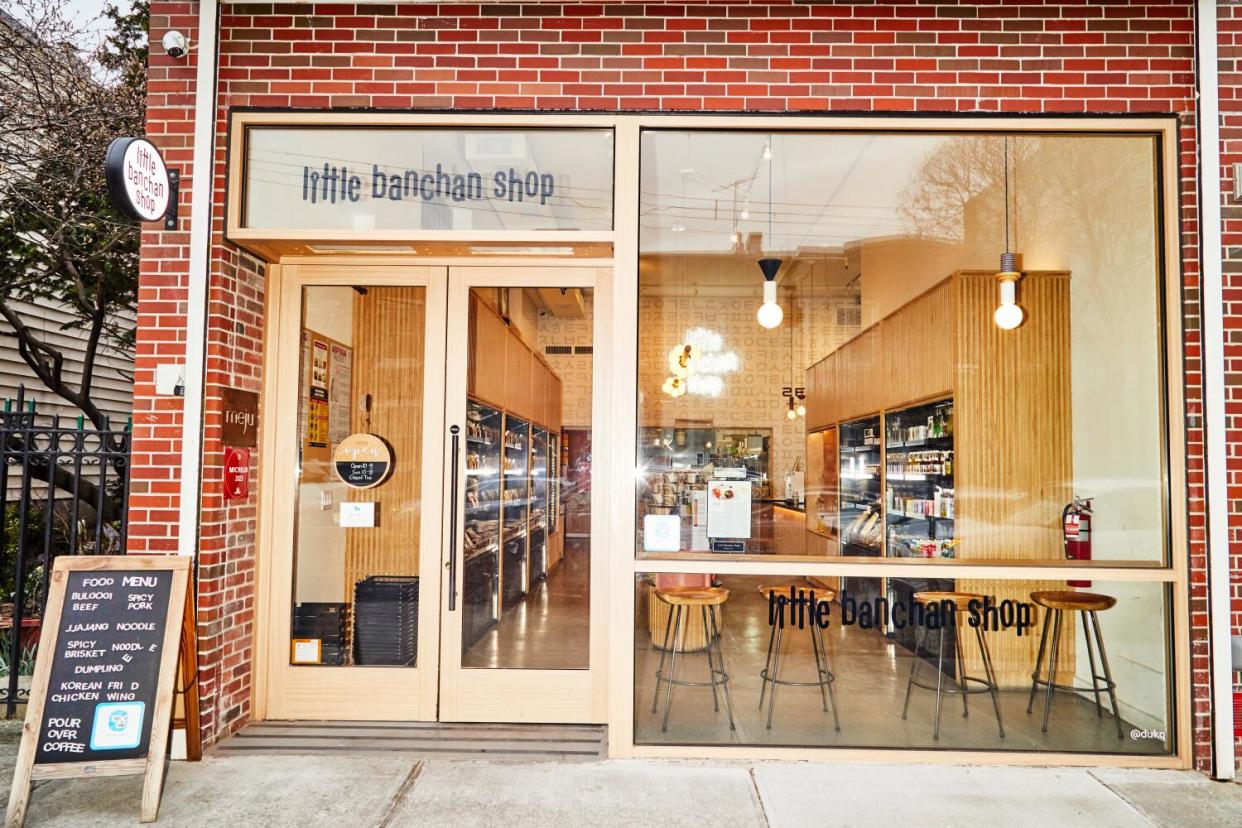
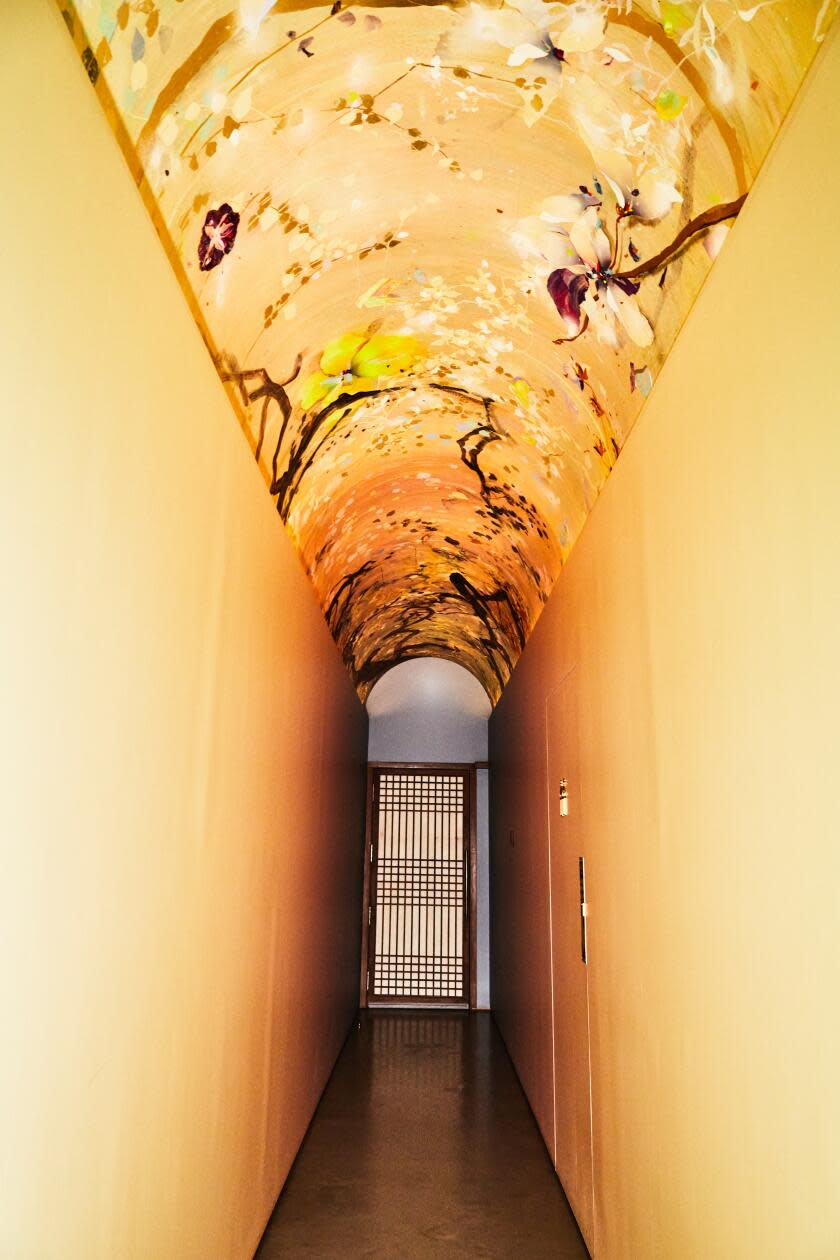
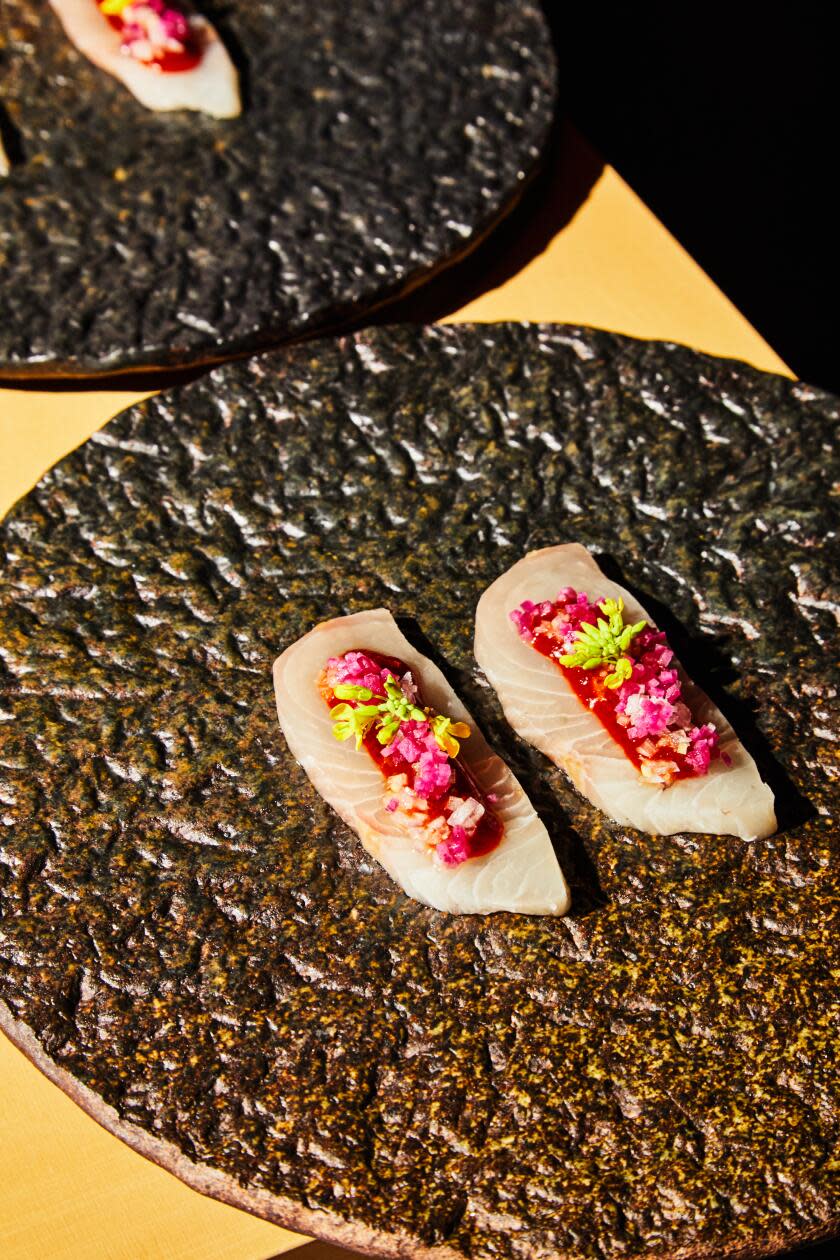
Meju is secreted in the back of the Little Banchan Shop, a charmer that brought to mind Jihee Kim’s wonderful Perilla L.A. near Echo Park. Walk down a short, dim hallway through an unmarked door and into a space that lands somewhere between a laboratory and a windowless omakase den, with room for eight customers around a marble counter.
Three or four nights a week, chef Hooni Kim and his team take to the stoves to assemble a meal centered on the literal bricks of classical Korean cooking.
While somms pour obscure whites from the Loire and servers gracefully heave stoneware platters the size of cafeteria trays, Kim frequently narrates the evening in words that feel impassioned and enlightening but never dogmatic. He details the namesake meju, boiled and mashed soybeans shaped into bundles, aged a few weeks and then swathed in rice stalks to properly ferment. This becomes a component for three key Korean ingredients: ganjang (soy sauce), doenjang (thick soybean paste) and gochujang (spicy paste made from gochu chile).
The meal began with a bowl of tofu and doenjang broth, its narcotic, earthy funk hitting the taste buds like surround sound reaching the ears. Chefs pulled fish and mushroom jeon straight from the pan to pair with a tasting of soy sauces, one of which was 128 years old. A ssam course with marbled beef, photo-shoot-perfect lettuces and a thrillingly intense few bites of pork collar smeared with jeotgal (preserved shrimp condiment) preceded a deliberately homey finish to the savory courses: pork belly braised in kimchi with rice, fried egg and sheets of gim.
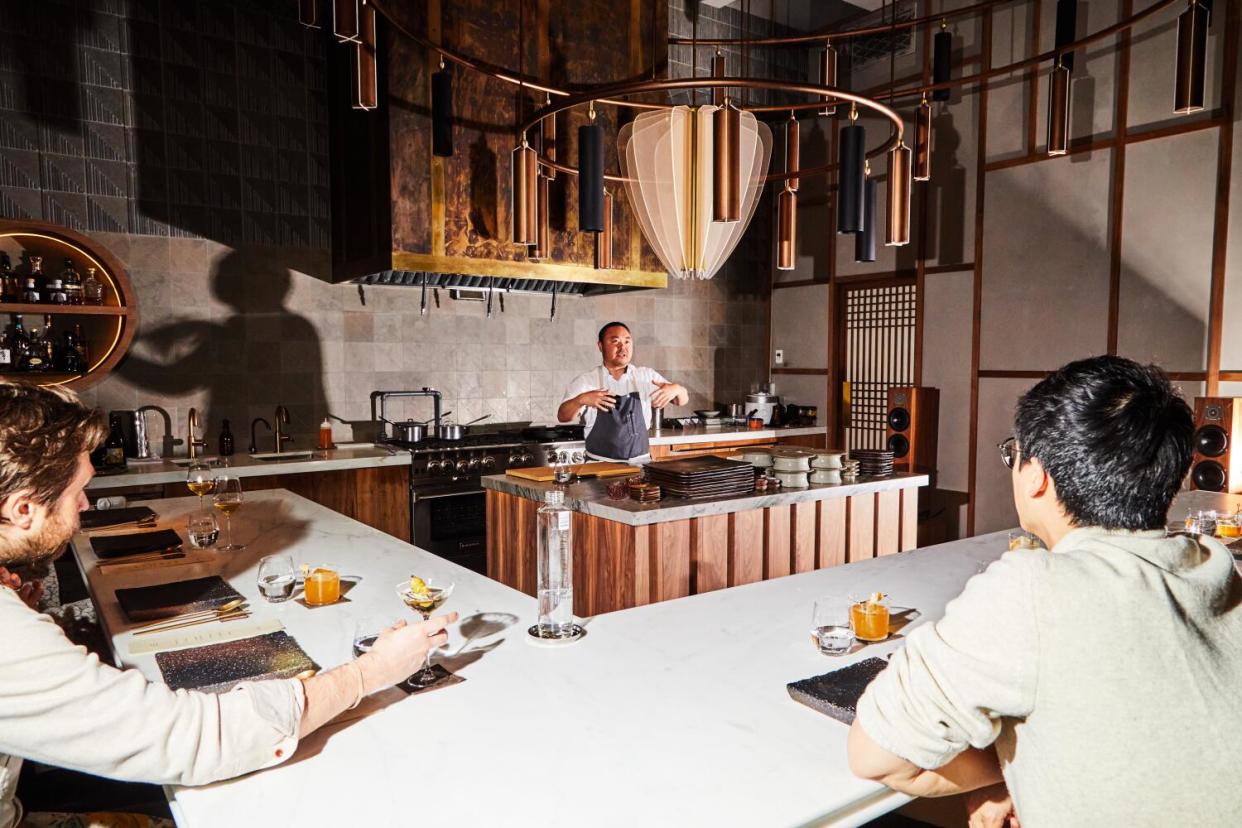
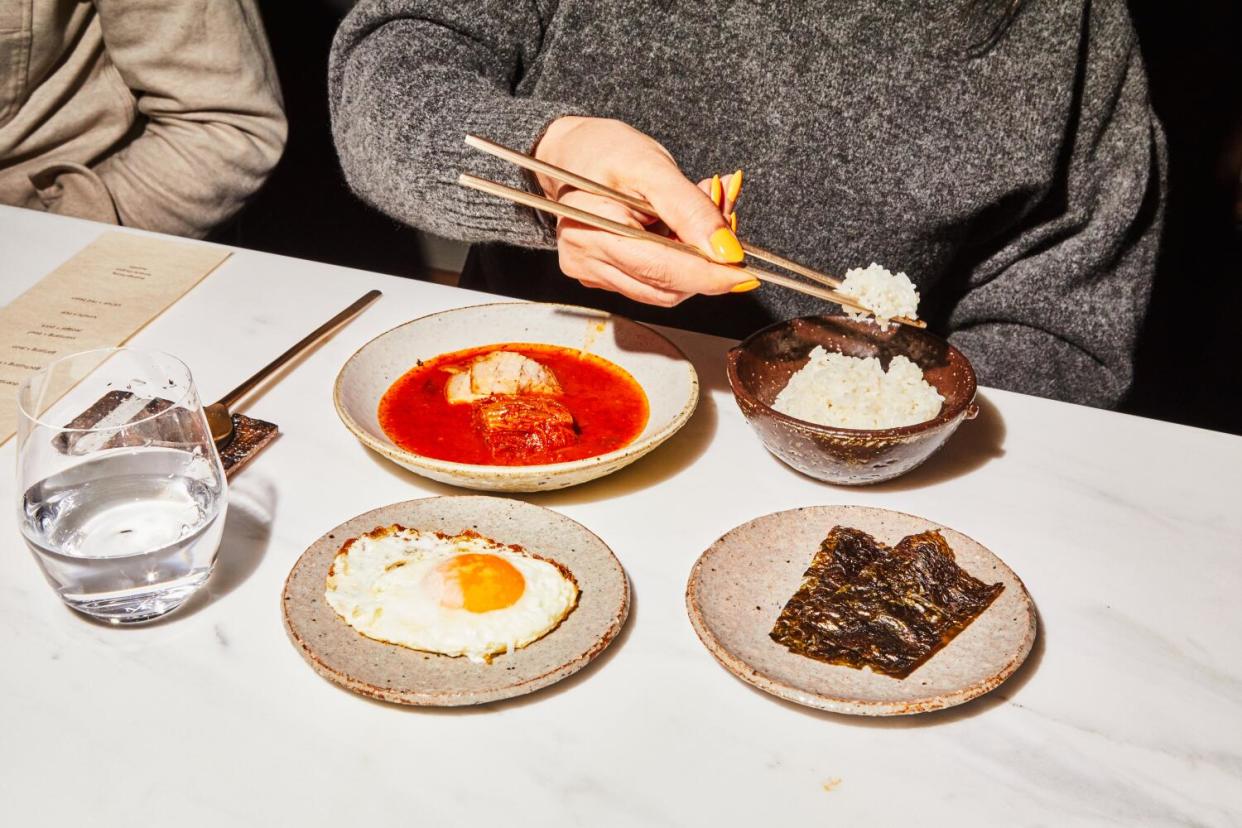
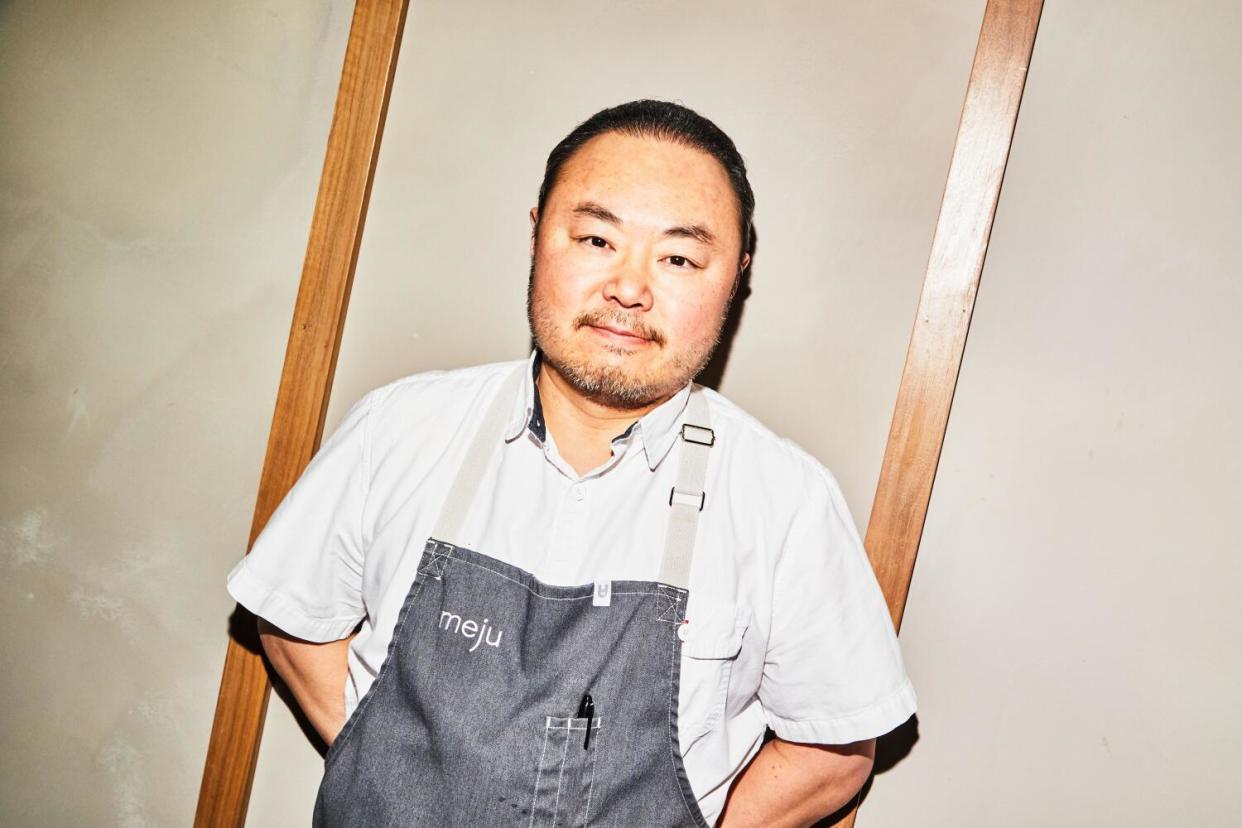
Kim previously ran two Manhattan restaurants focused on modern interpretations of Korean cuisine, Danji and Hanjan, but in the aftermath of the 2020 crises he found himself drawn back to drilling down on direct Korean flavors. We had a conversation after the meal, and he mentioned that sometimes he’ll ask customers during service if they miss the truffles and caviar and uni in this kind of setting. Most people don’t leave wanting.
“I appreciate the broadening range of Korean food,” Kim said. "But I felt what Korean food was is being a little lost. The history of Korean food is what attracts me more to Korean food now. And, you know, that’s the great thing about New York. I do feel like we have enough diners who will appreciate something like this and also something like Atomix.”
Agreed. But if I could teleport one of these modernist New York high-fliers in a blink, it would be Meju. Because it tastes like Los Angeles.
This story originally appeared in Los Angeles Times.
